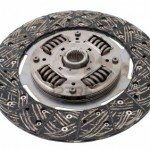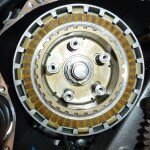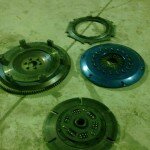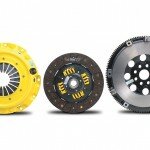CLUTCHES
July 11, 2007 – 5:26 pm
 The clutch is a tool for transmitting rotation. It can be either engaged or disengaged. It has two rotating shafts. One is pulley operated and the other uses another technique. The clutch connects two shafts in a pulley so that locked together it can spin at the same speed or when the coupling is disengaged they can spin at different speeds.
The clutch is a tool for transmitting rotation. It can be either engaged or disengaged. It has two rotating shafts. One is pulley operated and the other uses another technique. The clutch connects two shafts in a pulley so that locked together it can spin at the same speed or when the coupling is disengaged they can spin at different speeds.
The underlying principle of various types of clutches is based on friction discs (one or more) pressed close together or against a flywheel with the use of springs. In heavy duty vehicles ceramic clutches are in use because it is more resistant to friction.
One wet variety of clutch is kept soaked in a cooling lubricant that keeps the surface clean and longevity. A dry clutch is the reverse and some energy is thus lost.
In a motorcar the clutch is operated by pressing on the pedal at the extreme left using hydraulics or cable connections from the pedal to the clutch. Although the clutch itself is quite close to the pedal this remote system is necessary to neutralize slight engine vibrations – engine mountings being always flexible by intention. If it had been rigid it would have been impossible to have smooth engagement. If there is no pressure on the pedal it means that the clutch plates are driving or engaged. Depressing the pedal means disengaging the clutch plates. The driver can now shift gears.
In a manual transmission there are cogs for gear selection. These have matching teeth so that the rotational speeds of the two are in harmony for the engagement. This matching is achieved by another clutch known as a synchronizer. This technique uses contact by friction to bring the two sections to similar speed. There is a locking device to disallow engagement of the teeth until all the speeds are matched with each other.



The radiator fan often has a clutch that is activated by heat. The driving and driven devices are separated by fluid. At low temperatures the consistency is thin allowing the clutch to slip. At higher temperatures the density of the fluid thickens allowing the fan to rotate freely. Also are available electronic clutches to lock the pulley with the compressor.
Clutches in most of the motorcycles are operated with the help of a clutch lever that is placed on the left side of the handlebar. If there is no pressure on the bar it means that the plates are engaged. By pulling the lever backwards towards the driver the clutch plates get disengaged allowing for shifting of gears. Some of the latest models of cars and mopeds have a centrifugal clutch devises. Racing models of motorcycles use slipper-clutches to negate engine-braking effects.
There are also dog clutches and cone clutches. Safety clutches are usually fixed on to garden mowers. If a rock or stump is hit then the clutch will slip. Other types of clutches are overrunning clutches, single plate and multi plate friction clutches, centrifugal clutches, semi centrifugal clutches, hydraulic clutches and electromagnetic clutches.
A manual transmission car has more than one clutch. Even automatic transmission cars have clutches. It is not just cars – many everyday tools have clutches. Cordless drills, chainsaws and yo yo’s too have clutches. Clutches are indispensable in tools that have two rotating shafts. It is the clutch that does the connecting work so that either these are locked together and spin at the same speed or they are disengaged and go round at different speeds. In a car the engine spins all the time but the wheels do not. So in order to stop the car without harming the engine the wheels have to be disengaged from the engine. The clutch does the trick.
The technique of clutch is connected to the principles of friction. Friction is used to measure how hard it is to slide a thing over another object. Every article has peaks and depressions. These cause the friction. Even the most apparently smooth surfaces have microscopic hills and valleys. The larger the difference the greater is the friction. The workings of a clutch are based on the friction between the clutch plate and the flywheel. When there is no pressure on the pedal the springs push the plate against the disc of the clutch. This in turn presses against the flywheel locking the engine to the transmission input shaft that causes these to spin at the same speed. The amount of force, which the clutch can stand, depends on the friction between the flywheel and the clutch plate and also the force the spring places on the pressure plate.
The friction material on the disc wears out causing problems for the clutch. The clutch then starts to slip. Power will not be transferred from the engine to the wheels. The wear and tear takes place when the clutch disc and the flywheel spin at different speed. When they are locked there is synchronization and no friction. Thus the life of the clutch depends a lot on the expertise of the driver. Another headache is worn out bearings. The symptom of this disease is a rumbling noise whenever the clutch is engaged.
In the case of automatic transmission several clutches are in the fray. These connect or disconnect many sets of planetary gears. The compressor of air conditioning in the car has a magnetic clutch. This enables the compressor to switch off even while the engine is running. With the current flowing through a magnetic coil fixed in the coil, the clutch engages. But when the current stops as when the air conditioning is switched off, the clutch gets disengaged.
To clutch on means to hold on to. Man gets his engineering ideas from Nature, the ultimate teacher. The clutch in our lives is our conscience linking us to Nature, telling us to cling on and tune in to the dancing steps of life around us – our environment, if we do not want our car to grind to a pathetic halt.
One Response to “CLUTCHES”
Nice piece of information.Helped a lot for my project.Thanks for putting this up.
-Stan
By Stanley on Sep 26, 2009